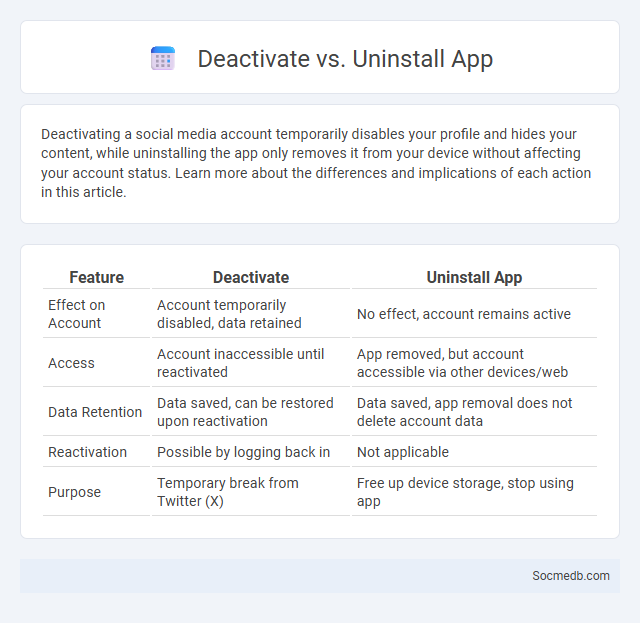
Photo illustration: Deactivate vs Uninstall App
Deactivating a social media account temporarily disables your profile and hides your content, while uninstalling the app only removes it from your device without affecting your account status. Learn more about the differences and implications of each action in this article.
Table of Comparison
| Feature | Deactivate | Uninstall App |
|---|---|---|
| Effect on Account | Account temporarily disabled, data retained | No effect, account remains active |
| Access | Account inaccessible until reactivated | App removed, but account accessible via other devices/web |
| Data Retention | Data saved, can be restored upon reactivation | Data saved, app removal does not delete account data |
| Reactivation | Possible by logging back in | Not applicable |
| Purpose | Temporary break from Twitter (X) | Free up device storage, stop using app |
Understanding App Deactivation, Uninstallation, and Deactivate Functions
Understanding app deactivation means temporarily disabling your social media account without losing data, allowing you to reactivate it later. Uninstallation removes the app from your device entirely but does not delete your account or data stored on the platform's servers. The deactivate function specifically restricts access and visibility on the social network while preserving your information for future use.
Key Differences Between Deactivating and Uninstalling an App
Deactivating a social media account temporarily disables your profile, preserving your data and allowing reactivation with your information intact, while uninstalling an app removes it from your device without affecting your account status or data stored on the platform. Deactivation ensures your profile and content remain invisible to others until you decide to return, whereas uninstalling only frees up device storage but leaves your account active and accessible via other devices. Understanding these distinctions helps users manage privacy and device resources effectively.
What Happens When You Deactivate an App?
Deactivating a social media app removes access to its features and stops background activity, though your account and data may remain stored on servers. Notifications are disabled, and the app no longer drains battery or data on your device. Reinstalling or reactivating the app typically restores your account and previous data without loss.
Effects of Uninstalling an App on Your Device
Uninstalling a social media app from your device significantly reduces digital distractions and improves battery life and storage capacity. It helps protect your privacy by limiting data sharing and decreases exposure to potentially harmful content, leading to better mental health and increased productivity. Users often experience enhanced focus and reduced anxiety after removing social media platforms from their daily routine.
Deactivation vs Uninstallation: Pros and Cons
Deactivating your social media account allows temporary suspension, preserving your data and contacts for easy reactivation, while uninstallation removes the app from your device, freeing up storage but keeping your account active. Deactivation offers privacy benefits and a mental break without losing your profile, whereas uninstallation helps reduce screen time but requires logging back in to access your account. Consider your digital habits and goals to decide which option suits your social media detox or management strategy best.
When to Deactivate Instead of Uninstalling
Deactivating social media accounts is ideal when users seek a temporary break without losing data or connections, allowing reactivation at any time. This option preserves profile information, posts, and friend lists, making it suitable for digital detoxes or privacy concerns. Uninstalling apps removes access but doesn't affect account status, so deactivation is preferred for pausing social media presence while maintaining all account content intact.
Data and Privacy Implications: Deactivation vs Uninstallation
Deactivating your social media account pauses your profile visibility but often retains your personal data on the platform's servers, leaving potential privacy risks unresolved. Uninstalling the app removes it from your device, yet your account and data may still be accessible online unless you remove the account itself. Understanding the distinction between deactivation and uninstallation is crucial for managing your data privacy effectively on social media platforms.
Permanent vs Temporary Removal: Which One to Choose?
Choosing between permanent and temporary removal on social media depends on your desired outcome and privacy needs. Temporary removal allows you to deactivate your account while preserving your data for potential reactivation, making it ideal if you want a break without losing your content. Permanent removal deletes your profile and all associated data irreversibly, so consider if you are certain about cutting ties with your social media presence before proceeding.
Common Scenarios for App Deactivation and Uninstallation
Common scenarios for app deactivation and uninstallation include concerns over privacy, excessive notifications, and declining interest in content or features. Users often deactivate accounts to take breaks from social media stress or to reassess their digital habits, while uninstallation typically follows prolonged inactivity or a desire to reduce screen time. Understanding these patterns helps you make informed decisions about managing your online presence effectively.
Best Practices for Managing Unused Apps
Regularly auditing social media accounts helps identify unused apps that may pose security risks or clutter user profiles. Revoking permissions for unused apps reduces data sharing with third parties and enhances privacy protection. Implementing a routine schedule for app review supports efficient account management and minimizes potential vulnerabilities.
 socmedb.com
socmedb.com